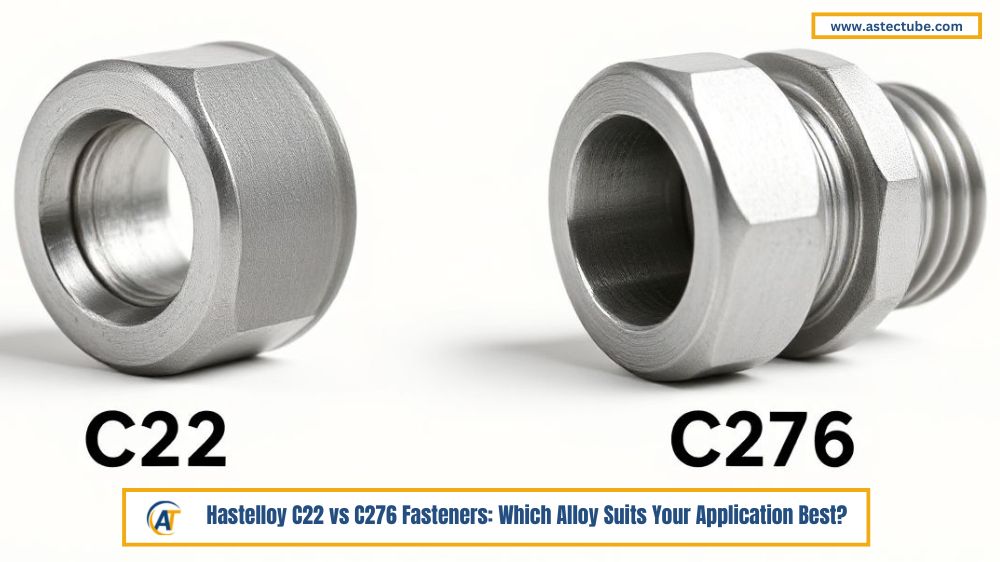In industries where extreme corrosion and high-temperature performance are non-negotiable, selecting the right grade of fasteners is critical. Hastelloy C22 and C276 fasteners are two premium choices widely used in harsh environments. While both offer superior resistance to chemicals and oxidizing agents, each alloy brings unique advantages. This comparison will help you understand their key differences and guide you in choosing the most suitable option for your industrial needs.
What Are Hastelloy C22 and C276 Fasteners?
Hastelloy C22 fasteners (UNS N06022) are nickel-chromium-molybdenum-tungsten alloy components designed to resist both oxidizing and reducing environments. They deliver top-tier performance in highly corrosive conditions. Meanwhile, Hastelloy C276 fasteners (UNS N10276) , another nickel-based alloy, blend nickel, chromium, molybdenum, and tungsten to resist a broad range of aggressive media, with particular strength in oxidizing environments.
Key Properties & Features
Composition & Mechanical Strength
-
C22 boasts ~22 % chromium, ~13 % molybdenum, and ~4 % tungsten. It delivers higher tensile and yield strength with excellent impact resistance.
-
C276 contains slightly lower chromium (~16 %), higher molybdenum (~16–17 %), and tungsten (3–4.5 %). It offers robust strength at elevated temperatures and higher toughness.
Corrosion Resistance
-
C22 excels in resisting pitting, crevice, and stress-corrosion cracking, especially in oxidizing acid environments like nitric acid, ferric chloride, and chlorine solutions.
-
C276 stands out against reducing acids like hydrochloric and sulfuric acid, and pitting agents like hypochlorite.
Temperature Performance
-
C276 holds up better at high temperatures (up to ~816°C), making it ideal for high-temperature industrial use.
-
C22 performs admirably but is slightly less temperature-tolerant.
Fabrication & Weldability
-
C22 offers easier weldability, better formability, and fewer weld-related corrosion risks in the heat-affected zone.
-
C276 is fabrication-friendly, though slightly less ductile than C22.
Industrial Applications
-
Oil & Gas: C22 is preferred in sour gas systems and desalination equipment, where chloride-induced corrosion is common. C276 fits systems with hydrochloric or sulfuric acid exposure.
-
Chemical Processing: C22 works well with oxidizing agents and mixed acids. C276 handles reducing acids, acid gas exposure, and bleed/vent systems.
-
Marine/Desalination: C22 resists saltwater pitting and crevice corrosion more effectively.
-
Power Generation & Pollution Control: C276 is ideal for high-temperature boilers and flue-gas desulfurization systems.
Comparison with Other Materials
Compared to stainless steel or Inconel alloys, both C22 and C276 offer far superior corrosion resistance. While Inconel alloys like 625 offer heat resistance, they struggle in reducing or chloride-laden environments where C22 and C276 excel.
Benefits for Specific Industries
-
Chemical / Pharma: C22 fasteners resist aggressive acidic and oxidizing conditions, improving safety and component longevity.
-
Oil & Gas / Petrochemical: C276 fasteners resist acid gas, HCl, and other corrosives under pressure and high temperature.
-
Marine / Desalination: C22 provides strong protection against chloride stress corrosion common in seawater infrastructure.
-
Power / Pollution Control: C276 handles high-temperature flue gas environments and acid condensation zones reliably.
How to Choose the Right Fastener Alloy
-
Match corrosion environment: Choose C22 for oxidizing conditions; C276 for reducing acidic environments.
-
Temperature ratings: Select C276 for exposure >500 °C.
-
Standards & Compliance: Use appropriate ASTM/ASME standards (e.g. ASTM F468, F467) for each alloy.
-
Supplier selection: Verify MTR (Material Test Reports), full chemical composition, and quality traceability.
-
Size & Geometry: Select fastener grades based on thread type, load/torque strength, and fatigue resistance.
For example, ASTM standards ASTM B575 (bars), ASTM B619 (flanges), or ASTM B626 (fasteners) govern fabrication and acceptance criteria.
Conclusion
Both Hastelloy C22 and C276 offer exceptional performance—but their strengths differ. Choose C22 fasteners when corrosion resistance in oxidizing media and chloride-rich environments is critical. Choose C276 for systems exposed to reducing acids or high-temperature corrosive gases. Your selection impacts safety, longevity, and ROI.
Understanding your operating environment—chemical exposure, temperature range, mechanical stress, and budget—ensures you pick the right fastener alloy. Invest in the proper grade, and your equipment will deliver unmatched performance and lifetime value.

